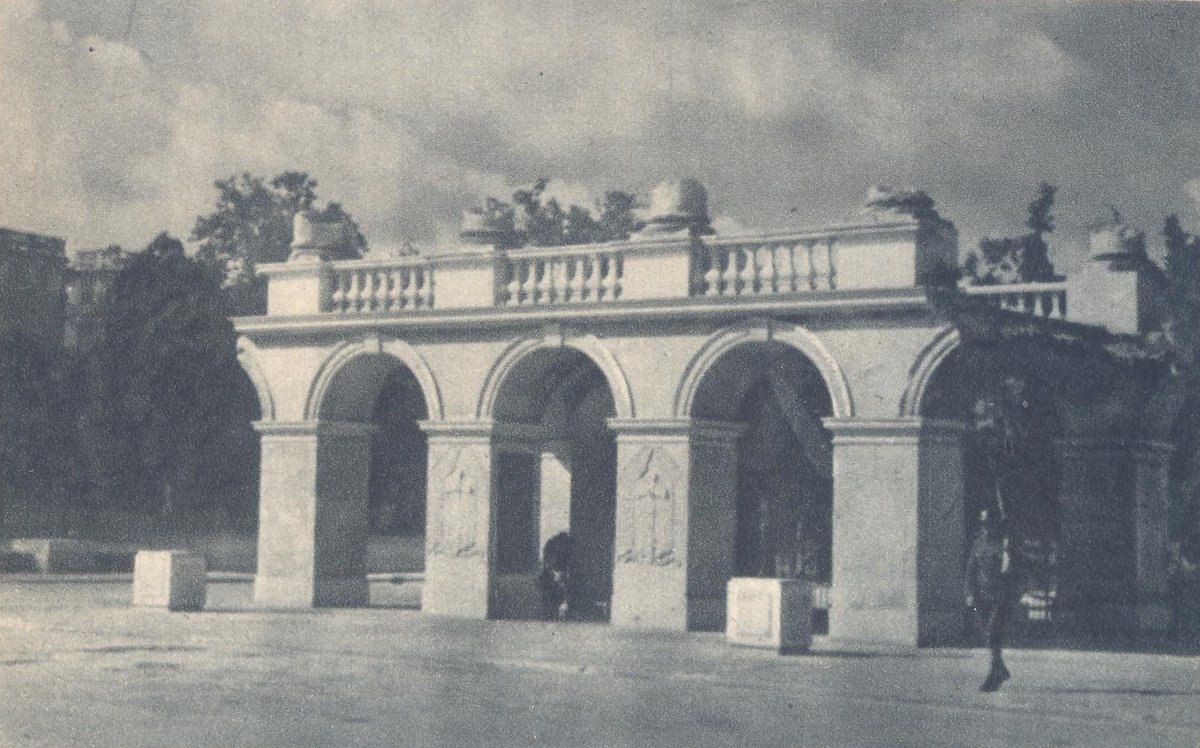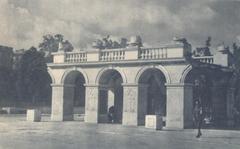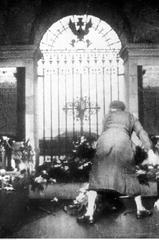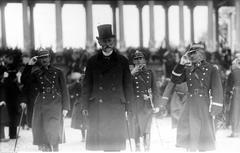
Tomb of the Unknown Soldier Warsaw: Visiting Hours, Tickets, and Travel Guide
Date: 14/06/2025
Introduction
The Tomb of the Unknown Soldier in Warsaw stands as one of Poland’s most iconic and significant national monuments. Located at Piłsudski Square, it honors the memory of unidentified soldiers who have given their lives for Poland’s freedom, symbolizing national sacrifice, resilience, and unity. Established in 1925 within the remnants of the historic Saxon Palace, the tomb is central both to Warsaw’s cityscape and to the nation’s commemorative traditions. The site features the eternal flame, an hourly changing of the guard, and inscriptions commemorating pivotal battles—making it not only a solemn memorial but also an essential stop for visitors interested in Polish history and culture.
This guide provides everything you need to plan a meaningful visit: historical context, architectural highlights, visiting hours, ticketing, accessibility details, nearby attractions, travel tips, and FAQs. For more background and practical information, refer to official resources such as monuments-remembrance.eu, Wikipedia, and Trek Zone.
Historical Background and Significance
Origins and Concept
The inspiration for the Tomb of the Unknown Soldier came from similar monuments in France and the UK following World War I, as Poland sought to honor the many nameless soldiers lost in its wars for independence (monuments-remembrance.eu). The idea took shape after 1918, with a national effort culminating in 1925 when the remains of an unidentified soldier—chosen from Lwów, a city symbolic of national struggle—were interred in Warsaw. Urns containing soil from fourteen key battlefields were buried alongside, representing all who sacrificed for Poland.
Architectural and Symbolic Features
Polish sculptor Stanisław Kazimierz Ostrowski designed the tomb within the surviving arcade of the Saxon Palace. The inscription, “Here lies a Polish soldier who fell for the Fatherland,” reflects its universal message. The monument is guarded 24/7 by the Polish Armed Forces, and the eternal flame burns continuously. The changing of the guard, performed hourly, is a moving ceremony that draws both locals and tourists (Wikipedia). Surrounding stone tablets list battles from World War I, the Polish-Soviet War, World War II, and other conflicts.
Wartime Survival and Postwar Restoration
Remarkably, while the Saxon Palace was destroyed by the Germans in 1944, the arcade housing the tomb survived. The site became a clandestine symbol of resistance during the occupation. In 1945, the tomb was among the first sites restored, with architect Zygmunt Stępiński preserving its status as a ruin-symbol of national loss and perseverance (History Then and Now). The tomb’s historical integrity has been maintained, with commemorative plaques updated to honor Poland’s full military legacy.
Visiting the Tomb of the Unknown Soldier: Essential Information
Location
The tomb is centrally located at Piłsudski Square, a major hub for national ceremonies and commemorations. It is adjacent to the Saxon Garden and within walking distance of other major sites such as the Grand Theatre and Presidential Palace (Warsaw Tourist Office).
Visiting Hours
The monument is accessible 24 hours a day, 7 days a week. The changing of the guard ceremony occurs every hour on the hour, year-round. Special ceremonies are held on national holidays, often drawing large crowds (Poland.pl).
Tickets and Admission
There is no entry fee or ticket required to visit the tomb or observe the guard ceremony. The site is open to all, making it one of Warsaw’s most accessible attractions.
Accessibility
- Wheelchair Access: The area is paved and features ramps, ensuring easy access for visitors with disabilities.
- Facilities: There are no restrooms or visitor centers at the site, but amenities are available nearby in the Saxon Garden and local cafés.
- Assistance: Guide dogs are permitted, and tactile paving is present in some areas.
Getting There
- Public Transport: The nearest metro station is Świętokrzyska (M1, M2), about a 10-minute walk away. Tram and bus stops (Królewska, Zachęta) are also nearby (Warsaw Public Transport).
- By Car: Limited parking is available; using public transport is recommended due to the central location.
Site Features and Etiquette
Layout and Artistic Elements
- Central Tablet: The soldier’s grave is marked by an inscribed stone slab and surrounded by five eternal flames.
- Commemorative Plaques: List key battles and military campaigns in which Poles fought.
- Military Honors: Emblems of the Virtuti Militari and Cross of Valor are displayed behind the tomb.
- Saxon Garden: Offers a peaceful green space for reflection just behind the monument.
Ceremonies and Rituals
- Changing of the Guard: Conducted hourly by the Representative Honour Guard Regiment, this ceremony is a highlight for visitors (Wikipedia).
- National Events: Major ceremonies occur on May 3 (Constitution Day), August 1 (Warsaw Uprising Anniversary), and November 11 (Independence Day), often with wreath-laying and official delegations.
Etiquette
- Maintain a respectful silence, especially during ceremonies.
- Photography is allowed, but flash and loud noises should be avoided.
- Laying flowers or wreaths at the tomb is permitted and encouraged on commemorative occasions.
Nearby Attractions
- Saxon Garden: Warsaw’s oldest public park, ideal for a reflective stroll.
- Grand Theatre – National Opera: Offers performances and guided tours.
- Presidential Palace: Historic seat of the Polish executive, open for exterior viewing.
- Zachęta National Gallery of Art: Modern art exhibitions nearby (Zachęta Gallery).
- Krakowskie Przedmieście: Bustling street with cafés, shops, and historic architecture.
Travel Tips
- Best Times to Visit: Early morning or late afternoon for quieter atmosphere and best light for photos.
- Guided Tours: Available through local agencies and often include other key Warsaw landmarks.
- Events: Arrive early for major ceremonies to secure a good viewing spot.
- Dress Appropriately: Modest attire is recommended, especially during official events.
Frequently Asked Questions (FAQ)
Q: What are the opening hours of the Tomb of the Unknown Soldier?
A: The site is open 24 hours a day, year-round.
Q: Is there an entrance fee?
A: No, admission is free.
Q: When does the Changing of the Guard take place?
A: Every hour, on the hour, daily.
Q: Is the site wheelchair accessible?
A: Yes, with paved paths and ramps.
Q: Can I take photos at the site?
A: Yes, but professional equipment or drones require special permission.
Q: Are guided tours available?
A: Yes, many city tours include the tomb and provide historical context.
Conclusion
The Tomb of the Unknown Soldier in Warsaw is a powerful symbol of Polish sacrifice, history, and unity. Its central location, open access, and moving ceremonies make it a must-visit for anyone interested in Poland’s past and present. Combine your visit with nearby sites like the Saxon Garden and Grand Theatre to experience the full depth of Warsaw’s cultural heritage.
For more information, updates, and guided audio tours, download the Audiala app and consult resources such as the Warsaw Tourist Office and Poland.pl.
Sources
- This guide references official and reputable sources for accuracy and further exploration:



































































































































































